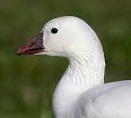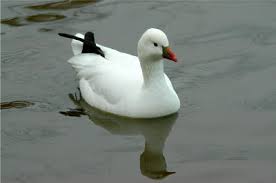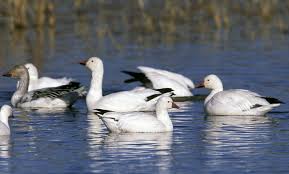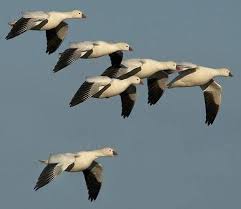The Ross's goose is a North American species of goose.
The American Ornithologists' Union places this species and the other two "white" geese in the genus Chen
rather than the more traditional "grey" goose genus Anser.
This goose breeds in northern Canada, mainly in the Queen Maud Gulf Migratory Bird Sanctuary, and winters
much further south in the continent in the southern United States and occasionally northern Mexico.
Description
The plumage of this species is white except for black wing tips. It is similar in appearance to a
white-phase snow goose but approximately 40% smaller. Other differences from the snow goose are that the
bill is smaller in proportion to its body and lacks "black lips". The dark phase is extremely rare.
The Ross's goose is a rare vagrant to Western Europe, but it is commonly kept in wildfowl collections and
so the true frequency of wild birds is hard to ascertain. Escaped or feral specimens are encountered
frequently, usually in the company of other feral geese such as Canada goose, greylag goose and barnacle
goose. However, individuals or small groups that seemed to be of natural origin have turned up in the
Netherlands and Britain.
This species is named in honor of Bernard R. Ross, a Hudson's Bay Company factor at Fort Resolution in
Canada's Northwest Territories.
Range
The breeding range of Ross’s goose spreads throughout the Canadian Arctic. In winter, flocks mostly migrate
to California, although congregations can also be found in Texas and northern Mexico. The range of this
species is thought to be spreading east. There have been reports of vagrant Ross’s geese in the Netherlands.
Habitat
During the breeding season Ross’s goose is found in Arctic tundra, where it nests in open areas and on
islands in shallow lakes. In winter, large aggregations are found in agricultural fields and shallow
wetlands, using nearby reservoirs and lakes to roost.
Behavior
Ross’s goose has an herbivorous diet, which consists of roots, leaves, stems, sedges, legumes and domestic
grains. This species can be seen foraging on the ground individually, or may form larger groups.
A migratory species, Ross’s goose leaves its breeding ground in mid-October and arrives in its overwintering r
ange in late October. Flocks begin to return to the breeding grounds in early March. While migrating, this
species is highly gregarious and forms large flocks.
Between late May and June mated pairs arrive at the breeding grounds and immediately establish a nesting
territory. Although Ross’s goose is thought to be monogamous, copulation with other individuals outside of
the pair is also known to occur. The female builds the nest during and after the territory establishment.
The nest is a shallow structure, with twigs, grass, moss and lichens in the outer layer and mostly down on
the inner layer. The female lays an average clutch of between 4 and 5 eggs at the beginning of June, which
are laid at 36-hour intervals. The female incubates the eggs, while being guarded by the male, and the eggs
hatch between late June and July. If the female leaves the nest, it will cover the eggs with a layer of
down to keep the eggs warm and hide them from predators. The young are able to leave the nest 24 hours after
hatching, and can swim and feed themselves. For up to a year after birth, the young maintain an association
with the adults and may remain with them until the next breeding season. Ross’s goose reaches sexual
maturity after 2 or 3 years, and lives for up to 14 years in the wild.
Migration
Most migration occurs through northwest and west-central Montana. Single or small groups of Ross's geese
often migrate with Snow Geese. About 20,000 to 40,000 stop at Freezeout Lake Wildlife Management Area each
spring and fall; this is approximately 20% of the total world population (Schwitters, personal communication).
Threats
Historically, Ross’s goose was threatened by hunting in its winter range, and this market drastically
reduced wild populations and may have threatened this species with extinction. Hunting became illegal in
1931 and the population has dramatically increased since, causing North American authorities to change the
law and allow hunting to resume, with the aim of reducing the population size by half.
As it is such an abundant species, there do not seem to be many threats to the future survival of Ross’s
goose, although habitat loss, disease and hybridisation with the snow goose (Chen caerulescens) may affect
population numbers in the future.








